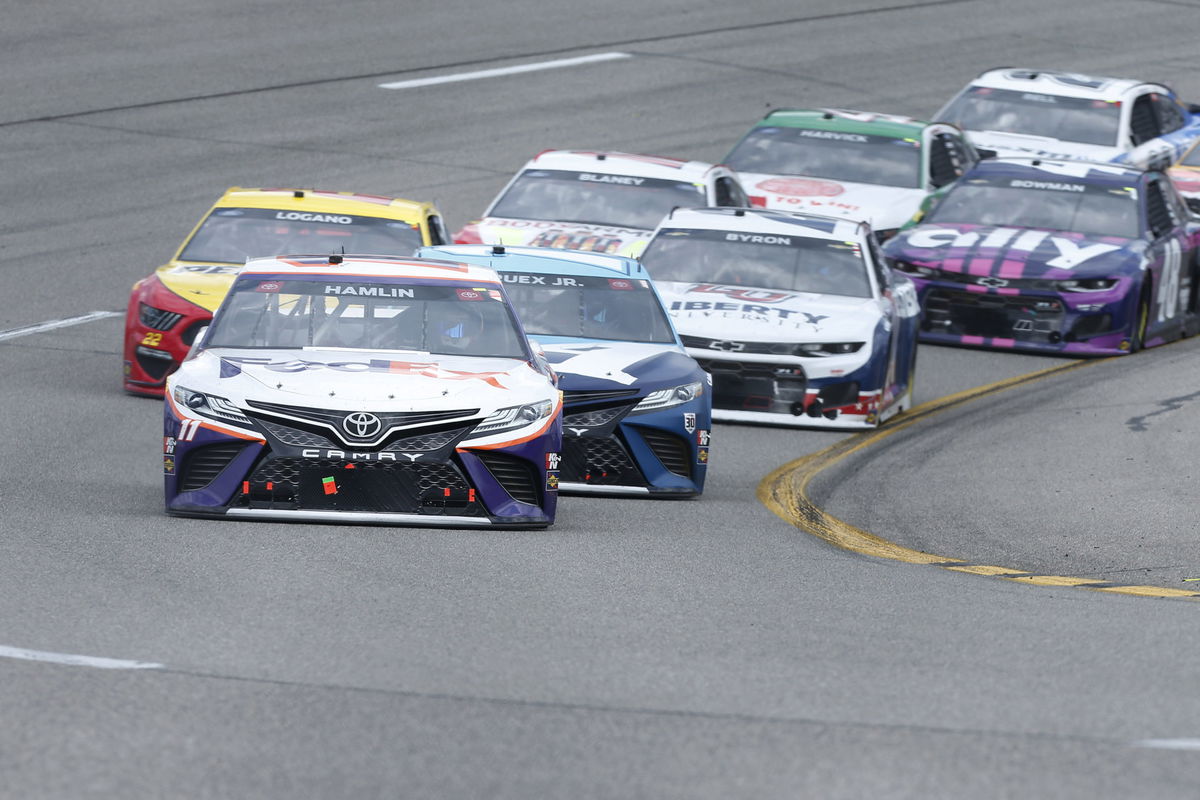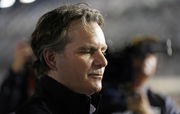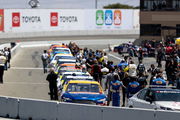
Imago
Apr 18, 2021; Richmond, Virginia, USA; NASCAR Cup Series driver Denny Hamlin (11) races NASCAR Cup Series driver Martin Truex Jr. (19) during the Toyota Owners 400 at Richmond International Raceway. Mandatory Credit: Amber Searls-USA TODAY Sports

Imago
Apr 18, 2021; Richmond, Virginia, USA; NASCAR Cup Series driver Denny Hamlin (11) races NASCAR Cup Series driver Martin Truex Jr. (19) during the Toyota Owners 400 at Richmond International Raceway. Mandatory Credit: Amber Searls-USA TODAY Sports
It looks like the standoff between NASCAR and participating teams is not going to end anytime soon. After facing the usual sponsorship issues and engaging in a row over the charter agreement that has constrained the sport, new potential issues have been building up in the background between NASCAR and the teams. Recently, NASCAR has felt the need to market the sport more efficiently, in line with the demands of the present times. The significance of such a marketing strategy is immense if NASCAR is to compete with rivals such as Formula 1, the NBA, and MLB, which continuously strive to expand to global audiences.
Watch What’s Trending Now!
NASCAR has recently introduced its new media rights deal with four broadcasters. The media rights deal will come into effect from the next season onwards and will run until 2031. The traditional broadcasters—Fox Sports and NBC Sports—will host 14 Cup Series racing events each. Mid-season races will be streamed on Amazon Prime Video and TNT Sports. The new media rights deal is valued at $7.7 billion, representing a 40% annual increase in NASCAR’s revenue from media rights compared to the current deal.
While the media rights deal caters to the needs and viewing patterns of modern-day audiences, the revenue it generates could be crucial in fulfilling NASCAR’s long-pending ambitions.
ADVERTISEMENT
NASCAR sets its eyes on making the sport global
NASCAR already has several programs in place that enable the sport to reach the far corners of the racing community. Over the years, NASCAR has been fortunate to attract committed fans who want the sport to reach new heights. To better market its exciting races and action-packed on- and off-track rivalries, NASCAR organizes numerous events, including fan events, car shows, and meet-and-greets. These events foster a strong connection with the audience. Additionally, NASCAR relies on community events, pre-race festivities, live music, and interactive exhibits. These measures have helped bolster NASCAR’s image among its die-hard fans.
https://twitter.com/A_S12/status/1833238142343909801
ADVERTISEMENT
However, the sport will be attempting to reach global audiences in the upcoming season. Many people widely consider the Cup Series points race at the Autódromo Hermanos Rodríguez in Mexico as the first step towards reaching international audiences. NASCAR is also considering introducing a driver’s incentive program as another crucial step to effectively market the sport. The basic idea behind this program is to centralize the marketing approach of the sport. As a result, the media handling of the respective teams will no longer remain relevant as the main marketing philosophy of the sport. The program requires everyone involved in NASCAR to prioritize the betterment of the sport rather than the interests of the team they are associated with.
NASCAR is planning to invest millions of dollars in the driver’s incentive program. However, rumors suggest that the sanctioning body has capped the initial amount at around $20 million. A significant portion of the program’s funding will likely come from the new resources available at NASCAR’s disposal. NASCAR has received around $820 million per year for media rights from Fox and NBC until now, and this number is certain to increase starting next season.
ADVERTISEMENT
The new driver’s incentive program reflects the fact that drivers are NASCAR’s main spokespersons. Through the program, NASCAR will emphasize that its drivers can engage in people-to-people interaction as representatives of the sport. The goal is to grow the sport by motivating drivers to do more promotional work, such as radio or TV interviews, in-person appearances, podcast hosting, social media posting, or autograph signings. The most popular structure for the driver’s incentive program, which NASCAR is discussing privately with the teams, is a rankings-based approach. In this system, NASCAR will award credits throughout the season for services performed, and the drivers will be reimbursed in proportion to their respective year-long scores.
Top Stories
Dale Earnhardt’s Grandson’s NASCAR Future Remains Unhindered Despite Major Team Rebranding Ahead of 2026

Richard Childress’ Champion Driver Joins Forces with HMS Crew Chief to Make Last Minute Chili Bowl Entry

Jeff Gordon’s NASCAR Rival Issues Public Verdict Years After His Apology

Cup Legend to Step Down From His Role as NASCAR Organization Names New Executive Leader

Ross Chastain Recalls the Relentless Grind That Kept His NASCAR Dream Alive After Sponsorship Spin-off

Concerns around the driver’s incentive programs
NASCAR, consideration of the driver’s incentive program could irreversibly change the way stock car racing is perceived across the globe. However, there are some serious concerns about the program. The most important of these is the racers’ commitment to this system. Fans and teams have been asking how a driver’s racing time and other commitments will be balanced once this program comes into effect. Concerns about their ability to race and deliver the performances expected by their teams are also issues that NASCAR needs to address.
ADVERTISEMENT

USA Today via Reuters
Feb 19, 2024; Daytona Beach, Florida, USA; NASCAR Cup Series driver William Byron (24) celebrates after winning the Daytona 500 at Daytona International Speedway. Mandatory Credit: Mark J. Rebilas-USA TODAY Sports
Other concerns surrounding this program revolve around NASCAR potentially jeopardizing the media operations of the teams. The organization’s attempt to gain more control through the program is another major reservation that has surfaced. Some fans have also questioned the need to centralize marketing at all. “Having traditional, pre-covid race weekends is the cheapest, fastest, easiest way to do this, yet NASCAR seems to not want to listen to the fans,” a curious NASCAR fan remarked.
What are your thoughts on the drivers’ incentive program? Tell us in the comments down below.
ADVERTISEMENT
ADVERTISEMENT
ADVERTISEMENT
ADVERTISEMENT

